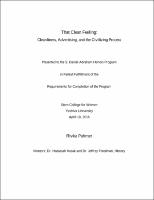Please use this identifier to cite or link to this item:
https://hdl.handle.net/20.500.12202/4203Full metadata record
| DC Field | Value | Language |
|---|---|---|
| dc.contributor.author | Pahmer, Rivka | - |
| dc.date.accessioned | 2018-11-12T20:14:47Z | - |
| dc.date.available | 2018-11-12T20:14:47Z | - |
| dc.date.issued | 2016-04 | - |
| dc.identifier.uri | https://hdl.handle.net/20.500.12202/4203 | - |
| dc.identifier.uri | https://ezproxy.yu.edu/login?url=https://repository.yu.edu/handle/20.500.12202/4203 | |
| dc.description | The file is restricted for YU community access only. | - |
| dc.description.abstract | It is well documented that beauty, body size, and fashion are preferences subject to changing norms and standards.1 Such a phenomenon is evidenced through even a cursory examination of art and beauty throughout the ages: Rubens’s voluptuous females – considered the epitome of the sensuous, beautiful ‘nude’ in his time 2 – would never get a job in Hollywood today, for instance. Paintings, statues, drawings, sketches, and even action figures demonstrate how certain body shapes are valued and idolized within a group of people at a given time.3 Accordingly, beauty and fashion are socially constructed; there are fundamental differences in the quintessential standard for each that can be traced temporally throughout history. At the same time, there are a number of attitudes and behavioral practices that seem to be universal, pre-cultural, and perhaps even innate. The drive for success, contact with others, nurturance, stable communities, and intelligence are values or attitudes that all people exhibit and strive for cross-culturally and throughout time.4 | en_US |
| dc.description.sponsorship | S. Daniel Abraham Honors Program | en_US |
| dc.language.iso | en_US | en_US |
| dc.publisher | Stern College for Women | en_US |
| dc.rights | Attribution-NonCommercial-NoDerivs 3.0 United States | * |
| dc.rights.uri | http://creativecommons.org/licenses/by-nc-nd/3.0/us/ | * |
| dc.subject | Hygiene --History. | en_US |
| dc.subject | Baths --History. | en_US |
| dc.subject | Advertising --Soap --History. | en_US |
| dc.subject | Advertising --Toilet preparations --History. | en_US |
| dc.subject | Advertising --Mouthwashes --History. | en_US |
| dc.subject | Cleanliness Institute (New York, N.Y.) | en_US |
| dc.title | That Clean Feeling: Cleanliness, Advertising, and the Civilizing Process | en_US |
| dc.type | Thesis | en_US |
| Appears in Collections: | S. Daniel Abraham Honors Student Theses | |
Files in This Item:
| File | Description | Size | Format | |
|---|---|---|---|---|
| Rivka-Pahmer.pdf Restricted Access | 2.45 MB | Adobe PDF |  View/Open |
This item is licensed under a Creative Commons License

